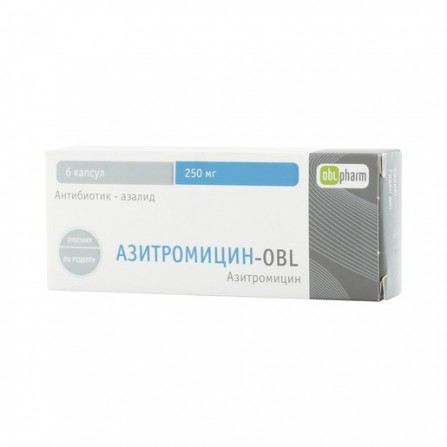Azithromycin-OBL capsules 250mg N6
Condition: New product
1000 Items
Rating:
Be the first to write a review!

More info
Active ingredients
Azithromycin
Release form
Capsules
Composition
1 capsule contains: azithromycin (in the form of dihydrate) 250 mg. Excipients: microcrystalline cellulose, povidone (low molecular weight polyvinylpyrrolidone, medical), crospovidone, calcium stearate, sodium lauryl sulfate. The composition of the shell is titanium dioxide, patent blue dye (patent blue V), diamond black dye, crimson dye (Ponzo 4R), azorubine, gelatin.
Pharmacological effect
The macrolide antibiotic is a representative of azalides. Inhibits RNA-dependent protein synthesis of sensitive microorganisms. Active against gram-positive bacteria: Staphylococcus aureus, Streptococcus spp. (including Streptococcus pneumoniae, Streptococcus pyogenes / group A /); Gram-negative bacteria: Haemophilus influenzae, Haemophilus parainfluenzae, Haemophilus ducreyi, Moraxella catarrhalis, Escherichia coli, Bordetella pertussis, Bordetella parapertussis, Borrelia burgdorferi, Neisseria gonorrze-off-an-off-hour-off-hour-off-hour-off-hour, aus-off-a-year-a-year-a-year-a-year-o-o. anaerobic bacteria: Bacteroides fragilis. Azithromycin is also active against Chlamydia trachomatis, Mycoplasma pneumoniae, Mycoplasma hominis, Treponema pallidum. It is also active against Toxoplasma gondii.
Pharmacokinetics
Rapidly absorbed from the digestive tract. Eating reduces the absorption of azithromycin. Cmax in plasma is achieved in 2-3 hours. It is rapidly distributed in tissues and biological fluids. 35% of azithromycin is metabolized in the liver by demethylation. More than 59% is excreted in the bile unchanged, about 4.5% in the urine unchanged.
Indications
Infections of the respiratory tract and upper respiratory tract (tonsillitis, sinusitis, otitis media, pharyngitis, bronchitis, tracheitis, pneumonia), soft tissues (infectious myositis, bursitis, soft tissue wounds, etc.), genitourinary system (cystitis, urethritis, cervicitis, gonococcal) infection, etc.), stomach ulcer, intestinal 12, etc.
Contraindications
Hypersensitivity to macrolide antibiotics. Severe abnormal liver and kidney function. Pregnancy. Breastfeeding (at the time of treatment is suspended). It is used with caution in cases of pronounced disorders of the liver, kidneys, cardiac arrhythmias (ventricular arrhythmias and prolongation of the interval are possible).
Precautionary measures
On the part of the digestive system: nausea, vomiting, flatulence, diarrhea, abdominal pain, transient increase in liver enzymes; rarely - cholestatic jaundice. Allergic reactions: rarely - skin rash, angioedema, erythema multiforme, Stevens-Johnson syndrome, toxic epidermal necrolysis. Dermatological reactions: rarely - photosensitivity.Co CNS: dizziness, headache; rarely - drowsiness, weakness. On the part of the blood system: rarely - leukopenia, neutropenia, thrombocytopenia. Since the cardiovascular system: rarely - chest pain. On the part of the genitourinary system: vaginitis; rarely - candidiasis, nephritis, increased residual urea nitrogen.
Use during pregnancy and lactation
Azithromycin crosses the placental barrier. Use during pregnancy is possible only in cases where the intended benefit to the mother outweighs the potential risk to the fetus. If necessary, the use of azithromycin during lactation should decide on the termination of breastfeeding.
Dosage and administration
Inside, 1 time / day. Bioavailability of pills does not depend on food intake. For infections of the upper and lower respiratory tract, skin and soft tissues (except for chronic migrating erythema): adults and children over 12 years old 500 mg 1 time / day for 3 days (course dose 1.5 g), children from 6 up to 12 years: at the rate of 10mg / kg of body weight 1 time / day for 3 days (course dose 30 mg / kg). In chronic erythema migrans to adults and children over 12 years of age, 1 time / day for 5 days: 1st day - 1.0 g (2 pills of 500 mg), then from the 2nd to 5th day - 500 mg (course dose 3.0 d), for children from 6 to 12 years old: on the 1st day in a dose of 20 mg / kg of body weight and then from 2 to 5th day - daily in a dose of 10 mg / kg of body weight (course dose 30 mg / kg ). For diseases of the stomach and duodenum 12 associated with Helicobacter pylori: 1 g / day (2 pills of 500 mg) for 3 days in combination with antisecretory agent and other drugs. For sexually transmitted infections, uncomplicated urethritis / cervicitis - 1 g once, complicated, long-lasting urethritis / cervicitis caused by Chlamydia trachomatis - 1 g three times with an interval of 7 days (1-7-14). Course dose 3 g.
Side effects
Rarely (in 1% of cases and less): On the part of the gastrointestinal tract, melena, cholestatic jaundice, bloating, nausea, vomiting, diarrhea, constipation, decreased appetite, gastritis. photosensitization, angioedema. From the urogenital system vaginal candidiasis, nephritis. From the cardiovascular system, heartbeat, chest pain. From the nervous system, dizziness, headache, vertigo, drowsiness,in children - headache (in the treatment of otitis media), hyperkinesia, anxiety, neurosis, sleep disorders. Other reversible moderate increase in liver enzymes, fatigue, itching, urticaria, conjunctivitis. In extremely rare cases of neutrophilia and eosinophilia. The changed indicators return to the normal range after 2-3 weeks after discontinuation of treatment. The occurrence of any side effect should be made known to the attending physician.
Interaction with other drugs
With the simultaneous use of ergot alkaloids can not exclude the risk of ergotism. With the simultaneous use of azithromycin with warfarin, cases of enhancing the effects of the latter are described. With simultaneous use of digoxin or digitoxin with azithromycin, a significant increase in the concentration of cardiac glycosides in the blood plasma and the risk of glycoside intoxication may occur. With simultaneous use with disopyramide described the case of ventricular fibrillation. When applied simultaneously with lovastatin, cases of rhabdomyolysis are described. With simultaneous use of rifabutin increases the risk of developing neutropenia and leukopenia. With the simultaneous use of disturbed metabolism of cyclosporine, which increases the risk of adverse and toxic reactions caused by cyclosporine.
special instructions
Not recommended for use in patients with impaired liver function. With caution used for violations of the kidneys. Azithromycin should be taken at least 1 hour before or 2 hours after meals or antacids.




